Abstract
The soil-water retention curve (SWRC) is fundamental in presenting the hydromechanical characteristics of soils, which are closely connected with soil deformation, permeability, and shear strength. The Fredlund and Xing (FX) model accurately fits the SWRCs of different types of soils over a wide suction range. However, experimental comparisons of the fitting showed that the obtained parameters differ from the physical meanings assigned by Fredlund and Xing. To address this issue, the traditional FX model has been improved, resulting in the proposal of a two-step FX model. Firstly, the FX model is applied without taking the correction coefficient c(ψ) into account to fit the measured SWRC. The values for α, n, and m are then determined and substituted into the FX model to refit the experimental data. Finally, the last parameter Cr can be obtained. The curves resulting from these two steps have a good agreement with the experimental results, and the obtained parameters align better with their physical meanings.
1. Introduction
The earth’s surface soils are particularly affected by the atmospheric environment, and changes in the atmospheric environment such as rainfall and evaporation can cause changes in the water content of shallow surface soils [1]. As shown in Figure 1, soils are saturated and the pore pressure is zero at the phreatic line. The soil layer between the phreatic line and the ground surface is unsaturated, and the pore pressure of this unsaturated soil is generally negative. The closer this soil layer is to the ground surface, the drier the soil becomes and the larger the negative pore-pressure value [1,2]. In order to characterize the change in the water content in the soil with depth, the relationship between the water content of the soil and the negative pore pressure was generally used. Later, the negative pore pressure was replaced by suction, and the curve expressing the relationship between the water content (gravimetric water content, volumetric water content, or degree of saturation) and suction was called the soil-water characteristic curve (SWCC), otherwise known as the soil-water retention curve (SWRC) [2]. The SWRC serves as the basis for presenting the hydromechanical properties of soils. The water retention property is closely linked to the soil’s deformation, permeability, and shear strength [3].
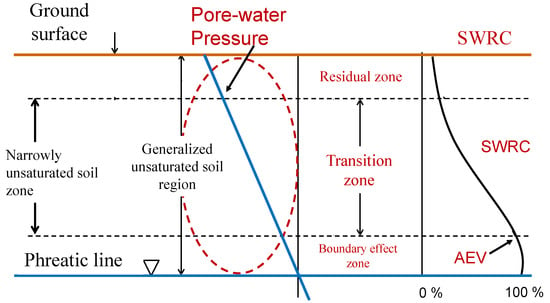
Figure 1.
Soil saturation in the vertical direction of the soil.
The SWRC is influenced by many factors, such as temperature, compactness, soil structural properties, and the pore solution concentration [4]. In recent decades, a large number of scholars have studied the effects of these variable factors on the water-retention property in soils [5,6,7,8]. Determination of the SWRC is mainly based on direct laboratory measurements and SWRC modeling. For direct laboratory measurements, the SWRCs of different suction bands are generally measured by means of a pressure plate apparatus, the filter-paper method and the saturated salt solution method, and if the SWRCs over a wide suction range are obtained, several methods should be used at the same time in conjunction with each other [8]. It takes one or two months to obtain an SWRC, even if several methods are carried out at the same time. Therefore, it is time-consuming to directly measure the SWRCs over a wide suction range for direct laboratory measurements. To overcome this shortcoming, many computational models for SWRCs were proposed [5]. These fitting formulas are the least-squares fit to limited test data using continuous mathematical equations. Usually, these fitting formulas contain some fitting parameters and are obtained during the fitting process. In addition, besides the formula-fitting method, some scholars have tried to use other properties of soil to directly determine the parameters of the SWRC and thus obtain the whole SWRC [3]. Subsequently, pore characteristics, such as pore-size distribution (PSD), have been used to directly calculate the SWRC [9,10,11].
At present, various formulas for fitting SWRCs have been proposed [5,9]. These equations are generally categorized into two-fitting-parameter equations, three-fitting-parameter equations, and four-fitting-parameter equations. These empirical equations can generally predict the SWRCs for a wide range of suction by fitting limited experimental data, and most of these equations are continuous and can be embedded into a constitutive model for unsaturated soils. Gardner [12] proposed an expression to express the relationship between suction and water content and used it to calculate the coefficient of permeability for unsaturated soils. Brooks and Corey [13] proposed a fitting formula containing two parameters (BC model), but this formula is mathematically discontinuous and difficult to be applied in a constitutive relationship of unsaturated soils. Moreover, the BC model is generally applicable to coarse-grained soils and does not fit the SWRC of fine-grained soils well. Van Genuchten [14] improved the BC model with the VG model, which makes the formula mathematically continuous and is also applicable to various types of soils. Fredlund and Xing [15] also proposed a soil-water model (the FX model) with four parameters, and these model parameters can be obtained by fitting the SWRC of unsaturated soils. The FX model is also applicable to various types of soils and has good prediction results over a wide suction range, especially compensating for the poor fitting of the VG model at high suction. Although the FX model still has some defects, this model is a widely used model for SWRCs.
2. Background
SWRC measurement is frequently costly, complex, and time-consuming. To overcome this limitation, a large number of fitting equations for SWRCs have been proposed. These fitting equations utilize continuous mathematical formulas to perform least-squares fitting on limited experimental data. Generally, these fitting equations contain several fitting parameters that are determined during the fitting process. The SWRC equations usually involve two, three, or four parameters. Typically, the model includes one parameter related to matric suction, one parameter representing the rate of saturation change, and a third parameter associated with the residual state.
The earliest model for SWRCs with two parameters is Gardner’s SWRC model [12]. Gardner proposed a relationship between volumetric water content and suction in the infiltration equation as follows:
where θω is the volumetric water content; θs is the saturated volumetric water content; θr is the residual volumetric water content; ψ is the suction; and αg and ng are fitting parameters. This SWRC equation is relatively simple, but it is rarely applied in practice, mainly due to its limitations and relatively low computational accuracy.
Brooks and Corey [13] divided the SWRC into two parts: one part represents the low-suction region, where the suction is smaller than the air-entry value (AEV), and the other part represents the high-suction region, where the suction is greater than the AEV. They provided separate expressions for these two regions (the BC model):
where αb is a fitting parameter related to the AEV and nb is a fitting parameter related to the PSD, respectively. It can be observed that the BC model is discontinuous, with significant abrupt changes on both sides of the AEV. This characteristic makes it unsuitable for application in the constitutive modeling of unsaturated soils.
To address the limitations of the BC model, van Genuchten [14] proposed a three-parameter SWRC model known as the VG model:
where αv and nv are the fitting parameters related to the AEV and PSD, respectively. The parameter mv represents the asymmetry of the SWRC. This equation improves the fitting accuracy in the low-suction range and is continuous, making it suitable for incorporation into constitutive models of unsaturated soils and applicable to various types of soil. However, this equation has the drawback of a relatively lower fitting accuracy in the high-suction region.
Based on the theory that the SWRC is controlled by the PSD, Fredlund and Xing [15] proposed an SWRC equation (FX model) that is similar to the van Genuchten model:
where α is a fitting parameter related to the suction at the turning point (TP) of the SWRC, n is a soil parameter related to the slope at the TP on the SWRC, and m is a fitting parameter related to the residual water content. To address the drawback of lower fitting accuracy in the high-suction range, Fredlund and Xing introduced a modification factor, c(ψ), to the original equation:
where Cr is the suction value corresponding to the residual water content. From Equations (5) and (6), it can be observed that the FX model contains four fitting parameters. Regarding the physical interpretations of these four parameters in the FX SWRC model, although Fredlund and Xing initially proposed the equation in 1994 and provided some explanations for the physical meanings of the parameters, many concepts were vague, and the physical interpretations were not well-defined. Subsequently, numerous researchers have studied the FX model or applied this model, but the majority of them treat these four parameters as fitting parameters, without providing explicit physical interpretations [16]. Fredlund [3] indicated that α in the equation represents a fitting parameter related to the suction at the inflection point of the SWRC, n is a fitting parameter associated with the maximum rate of soil dewatering, m is a fitting parameter related to the curvature at the residual moisture content, and Cr represents a fitting parameter associated with the residual suction.
3. Problems with the FX Model
From many of the fitting results, the actual values of these fitting parameters differ significantly from the physical meanings given by Fredlund and Xing, especially for the fitting parameter Cr. Thus, the physical meanings of these fitting parameters are still not clear and still need to be further explored. In particular, the Cr value is treated as a constant value of 3000 kPa by Fredlund and Xing [3,15,17]. However, the Cr value is the suction value at the residual state as defined by Fredlund and Xing [15], and the residual suction is different for different types of soils and varies considerably; if this fitting parameter is treated as a constant, that is contradictory. Moreover, many scholars have also studied the Cr value [16,17,18,19], and most of them also treat it as a constant, e.g., Sillers and Fredlund [17] also treated the Cr value as a constant value of 3000 kPa; Zhai and Rahardjo [16] treated this value as a constant value of 1500 kPa; and Fredlund and Zhang treated the Cr value treated as a constant value of 2000 kPa [18]. Leong and Rahardjo [19] even suggested that c(ψ) in the equation for the SWRC of Fredlund and Xing could be considered as having a value of 1, which would make the calculations much more streamlined, and the fit would satisfy the requirements. However, Zhai and Rahardjo [20] pointed out that the value of Cr has a particularly strong influence on the FX SWRC model and that the determination of the value of Cr needs to be further investigated.
There is no doubt that the fitting results of the FX SWRC equation are relatively satisfactory, and it is one of the more widely used models, but the parameters obtained from the calculations differ significantly from the physical meaning defined by Fredlund and Xing, so further research on the fitting parameters of the FX SWRC equation is necessary. The problem of the parameters of the FX SWRC equation is investigated using the measured SWRC of undisturbed complete-intense weathering mudstone (data from [21]).
Figure 2 shows the results of fitting the SWRC for the undisturbed complete-intense weathering mudstone using the FX model, the fitted parameters of which are shown in Table 1. It can be seen from Figure 2 that the test data can be fitted well using the FX soil-water model. Generally, the conventional graphical method is used to determine the true SWRC variables (AEV, RV etc.): draw the tangent line through the inflection point, followed by a horizontal line through the initial point and another tangent line through the point where the curve starts to drop linearly in the high suction range. Finally, the intersections of these tangent lines indicate the AEV and the RV. Based on the above method, the AEV, the suction at the TP, and the suction at the RV is about 340 kPa, 2500 kPa, 35,000 kPa, respectively. Comparing the parameters fitted to the FX soil-water model (Table 1) with the parameters of the SWRC obtained by the graphical method, it can be seen that α does not differ significantly from the suction at the TP, but Cr differs significantly from the suction at the RV, even by several orders of magnitude.
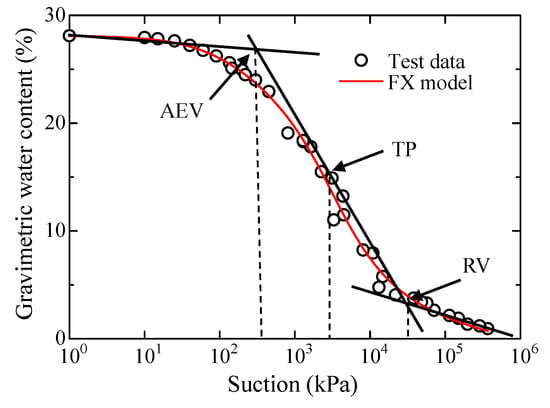
Figure 2.
Measured SWRC and fitting curve by the FX model for undisturbed complete-intense weathering mudstone.

Table 1.
The parameters obtained by PSDs for undisturbed complete-intense weathering mudstone.
Figure 3 shows the results of fitting the SWRC of Pearl clay (data from [22]) using the FX model, and the fitted parameters of the FX soil-water model obtained from the fitting are detailed in Table 2. It can be seen that the test data can be fitted well using the FX soil-water model. According to the definition of true SWRC parameters by the graphical method, it can be seen from Figure 3 that the AEV of Pearl clay is about 30 kPa, the suction related to the TP is about 200 kPa, and the suction at the RV is about 1600 kPa. Comparing the fitted parameters (Table 2) of the FX model with the measured parameters of the SWRC obtained by the graphical method, it is found that the value of the fitted parameter α is indeed closer to the value of the suction at the turning point, but the value of the fitted parameter Cr is somewhat different from the value of the suction at the RV; however, this difference is not particularly large.
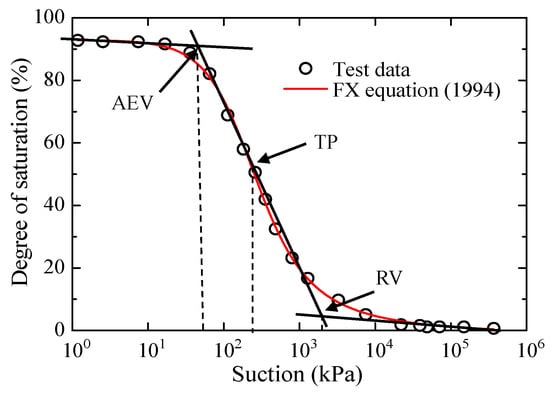
Figure 3.
Measured SWRC and fitting curve by the FX model for compacted Pearl clay (data from [22]).

Table 2.
The parameters obtained by PSDs for Pearl clay.
Figure 4 shows the fitting results of Boom clay using the FX model, where it can be seen that the fitting curve is relatively close to the test data. The relevant fitting parameters are detailed in Table 3. From Figure 4, using the graphical method, the AEV of Boom clay is about 500 kPa, the suction at the TP is about 9000 kPa, and the suction at the RV is about 300,000 kPa. Comparing the fitted parameters (Table 3) of the FX model with the parameters of the SWRC obtained by the graphical method, it can be seen that the value of the fitted parameter α differs significantly from the suction value at the TP by several orders of magnitude, while the value of the fitted parameter Cr also differs significantly and by orders of magnitude from the suction value at the RV.
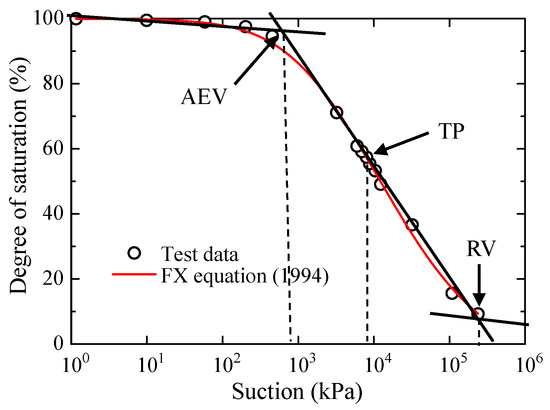
Figure 4.
Measured SWRC and fitting curve by FX model for compacted Boom clay (data from [23]).

Table 3.
The parameters obtained by PSDs for Boom clay.
By comparing the results of the fitted data for the above three soils and combining them with data results from the literature, it can be determined that the fitted parameters of the FX model are more in line with the physical meaning when fitting coarse-grained soils (sandy soils); however, for fine-grained soils (clays, especially expansive soils), the fitted parameters are very different from the physical meaning. Therefore, for clay soils, the applicability of the method needs to be further explored when utilizing the FX model. Figure 5a represents the fitting curves (Equations (6)–(8)) of undisturbed complete-intense weathering mudstone using the FX model. These show that Sr1 remains largely unchanged below a suction of 2000 kPa, but at an upper suction of 2000 kPa, the curve begins to decrease, though not significantly. c(ψ) varies considerably during the whole suction range. Theoretically, it is reasonable for Sr1 to play a dominant role, but in the actual fitting process, c(ψ) plays the dominant role. Thus, a partial restriction on the fitting process is required. Based on the above analysis, when using the FX model, in order to let Sr1(ψ) take on the dominant role, it was considered to first fit the test data with the Sr1(ψ) formula and then to refit the test data once again using the FX model with c(ψ), which could determine the parameter Cr, whose fitted data is shown in Figure 5b. It can be seen that Sr1(ψ) is not fixed at 1 within the full suction range, indicating that Sr1(ψ) starts to play a major role in the fitting process, while c(ψ) only plays a role in the high suction range, which can regulate the phenomenon of the fitted curve of (ψ) being too high in the high suction range.

Figure 5.
The contribution of Sr1 and Cr in the fitting process (for undisturbed complete-intense weathering mudstone).
In order to investigate the effect of the initial setting parameters on the fitting curve, some tests were conducted. Before fitting, the fitting parameters α and Cr were pre-set within a range, then Equation (6) was used to fit the test data. The initial limit ranges of α and Cr are shown in Table 4. Figure 6 shows the fitting curves with the different conditions in Table 4. It can be seen that the best fitting effect was achieved without parameter limitations (Test F7). In addition, the fitting curve in Test F1 was also relatively close to the experimental data. However, the fitting curves in Tests F2–F6 were not in good agreement with the test data. The fitting parameters of the FX model of the seven tests are listed in Table 4 (Last column). Through comparison, the fitting parameter α was found to be the upper limit of the initial setting limit, while the parameter Cr was the lower limit of the initial setting limit in every test. Through these experiments, it can be seen that only for larger values of α and smaller values of Cr can better fitting results be obtained. In fact, the parameters α and Cr have already violated their physical meaning in the case of the best fitting (AEV, 350 kPa; suction of the RV, 35,000 kPa). In summary, although the fitting results are relatively good, when simply using this model to fit the curve, the obtained fitting parameters do not conform to physical meanings.

Table 4.
The fitting parameters in the FX model with different setting conditions.
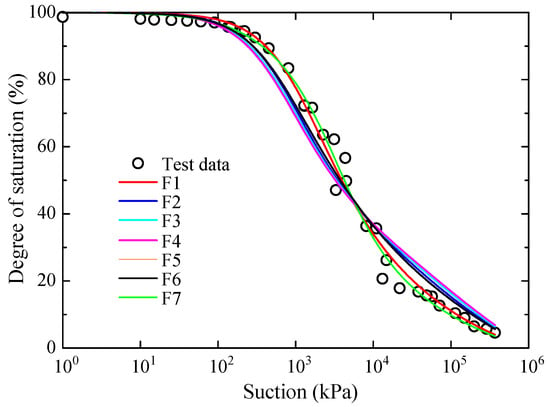
Figure 6.
The calculations by the FX model with different setting parameters.
4. A Modified Method of the FX Model
Based on the above analysis, when applying the FX model, the process can be divided into two steps: The first step is to first fit the test data using Sr1(ψ) (Equation (7)), which can obtain the parameters α, n, and m. The second step is to use the FX model with C(ψ) (Equation (6)) by substituting the obtained parameters α, n, and m from first step to fit the test data again; then, the last parameter Cr can be obtained. In order to verify the validity of this method, this fitting step was used to fit the test data for the SWRCs of Boom clay [22], undisturbed complete-intense weathering mudstone [21], and silty sand [23].
The existing FX model (Equation (6)), the Sr1 FX model without the correction parameter c(ψ) (Equation (7)), and the improved FX soil-water model (stepwise FX model) were used to fit the experimental data from the SWRCs of Boom clay, undisturbed complete-intense weathering mudstone and silty sand, respectively. Then, the fitting curves and fitting parameters from the three fitting equations were compared.
Figure 7, Figure 8 and Figure 9 show the results of fitting results for the Boom clay, undisturbed complete-intense weathering mudstone and silty sand, respectively. It can be seen from these plots that the same conclusion is reached for all three soils. Both the stepwise FX model and the classical FX model can be used to fit the test data well, while the fitting curves obtained by the FX model without the correction factor C(ψ) differ significantly from the measurements, especially in the higher suction range, where the fitting curves are much higher than the test values. Table 5, Table 6 and Table 7 show the fitted parameters of the one-step fitting method and the multistep fitting method, and the true values by the graphical method of the three soils. It can be seen that although there is no difference in form between the stepwise FX model and the classical FX model, with adjustments made only to the steps, the values of the fitted parameters are particularly different, particularly for the fitted parameters α and Cr. As can be seen from the tables, for the classical FX model (one-step fitting), the parameter α is relatively larger, sometimes even several orders of magnitude greater than the true suction at TP, while the parameter Cr is relatively smaller, of several orders of magnitude lower from the true suction at RV, which is obviously very unreasonable. In contrast, the fitted parameters α and Cr obtained from the stepwise FX models are not very different from the true values and are more consistent with their respective physical meanings. Although both the stepwise FX model and the classical FX model can fit the test data well, the stepwise FX model is more reasonable given the physical significance of the fitting parameters. Therefore, when using the FX model to predict the SWRC, it should be fitted in steps, first using Equation (7) to determine the parameters α, n, and m and then substituting these three parameters into Equation (6) to fit the test data again. Then, the last parameter Cr can be obtained, and the fitted curve can match the test data well, and all the parameters can also conform to their physical meanings.
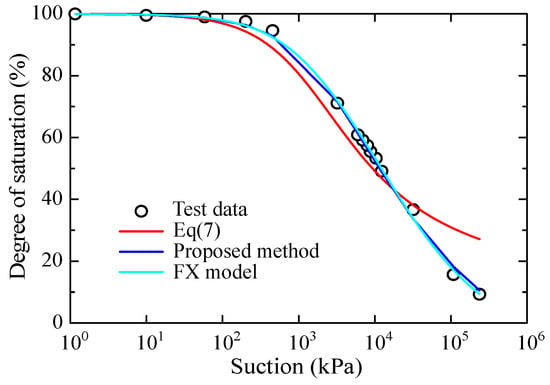
Figure 7.
Measured SWRC and fitting curve by the modified FX model for compacted Boom clay (data from [23]).
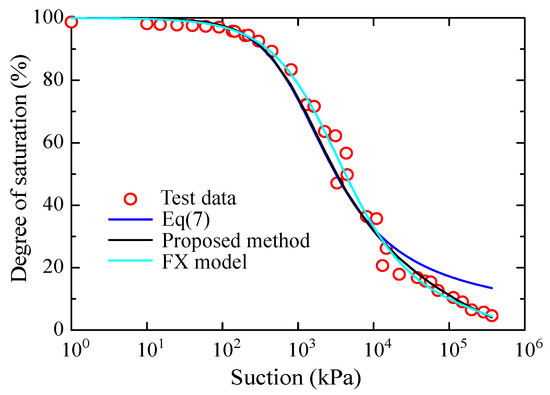
Figure 8.
Measured SWRC and fitting curve by the modified FX model for undisturbed complete-intense weathering mudstone. (data from [21]).
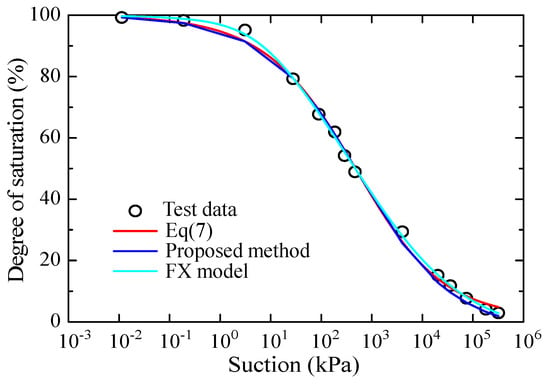
Figure 9.
Measured SWRC and fitting curve by the modified FX model for silty sand (data from [24]).

Table 5.
The fitting parameters in the FX and modified FX SWRC models for Boom clay.

Table 6.
The fitting parameters in the FX and modified FX SWRC models for undisturbed complete-intense weathering mudstone.

Table 7.
The fitting parameters in the FX and modified FX SWRC models for silty sand.
5. Conclusions
The FX model fits the measured SWRCs of different types of soils well over a wide suction range, but a series of fitting comparisons showed that the fitting parameters were relatively different from the physical meanings assigned to them by Fredlund and Xing. To remedy this shortcoming, a simple and effective method has been proposed. Firstly, the influence of various combination parts in the FX model on the fitting effect was investigated. Based on the above analysis, when using the FX model, it is necessary to proceed in two steps: First, the FX model is used to fit the test data without considering the correction coefficient c(ψ), and the parameters α, n, and m are determined. Then the three parameters are substituted into the existing FX model to fit the test data again, and the final parameter Cr can be obtained. The proposed method is verified by the experimental SWRC data of different types of soils. The fitting curves obtained by these two steps are in good agreement with the test data. Importantly, the fitting parameters obtained by the proposed method conform to their physical meanings.
Author Contributions
Methodology, G.N.; Validation, F.C.; Data curation, G.N.; Writing—original draft, G.N.; Writing—review & editing, Y.M. and X.L.; Supervision, L.K.; Funding acquisition, G.N. All authors have read and agreed to the published version of the manuscript.
Funding
This research was funded by National Natural Science Foundation of China, grant number 42307236; Natural Science Foundation of Shandong Province, grant number ZR2023QE001; Open Research Fund of State Key Laboratory of Geomechanics and Geotechnical Engineering, grant number SKLGME021019; The Ministry of Education’s "Chunhui Plan" Collaborative Research Project, grant number 202201864.
Data Availability Statement
The data presented in this study are available on request from the corresponding author. The data are not publicly available due to privacy restrictions.
Conflicts of Interest
The authors declare no conflict of interest.
References
- Lu, N.; Likos, W.J. Unsaturated Soil Mechanics; John Wiley & Sons, Inc.: Hoboken, NJ, USA, 2004. [Google Scholar]
- Fredlund, D.G.; Rahardjo, H. Soil Mechanics for Unsaturated Soils; John Wiley & Sons, Inc.: Hoboken, NJ, USA, 1993. [Google Scholar]
- Fredlund, D.G. State of practice for use of the SWRC (SWCC) in geotechnical engineering. Can. Geotech. J. 2019, 56, 1059–1069. [Google Scholar] [CrossRef]
- Gao, Y.; Sun, D.A.; Zhou, A.N.; Li, J. Effect of stress state on soil-water retention and its application on the strength prediction. Géotech. Lett. 2018, 8, 324–329. [Google Scholar] [CrossRef]
- Niu, G.; Shao, L.T.; Sun, D.A.; Guo, X.X. A simplified directly determination of soil-water retention curve from pore size distribution. Geomech. Eng. 2020, 20, 411–420. [Google Scholar]
- Feng, S.; Leung, A.K.; Zhan, L.T.; Liu, H.W.; Wang, M.; Guo, X.K. Effects of hydrogen sulphide on grass traits and water-gas transport in grass-planted unsaturated soil. Géotechnique 2023, in press. [Google Scholar] [CrossRef]
- Ma, T.T.; Wei, C.F.; Chen, P.; Li, W. Chemo-mechanical coupling constitutive model for chalk considering chalk-fluid physicochemical interaction. Géotechnique 2019, 69, 308–319. [Google Scholar] [CrossRef]
- Zhang, J.; Liu, J.; Cheng, Y.; Jiang, T.; Saberian, M. Water-retention behaviour and microscopic analysis of two biopolymer-improved sandy soils. Constr. Build. Mater. 2023, 403, 133202. [Google Scholar] [CrossRef]
- Niu, G.; Shao, L.T.; Guo, X.X. A simplified directly determination of soil-water retention curve variables. Geomech. Eng. 2020, 23, 431. [Google Scholar]
- Kong, L.W.; Tan, L.R. A simple method of determining the SWRC indirectly. In Proceedings of the Asian Conference on Unsaturated Soils, Singapore, 18–19 May 2000. [Google Scholar]
- Sun, W.J.; Cui, Y.J. Determining the soil-water retention curve using mercury intrusion porosimetry test in consideration of soil volume change. J. Rock Mech. Geotech. 2020, 12, 1070–1079. [Google Scholar] [CrossRef]
- Gardner, W.R. Some steady-state solutions of the unsaturated moisture flow equation with application to evaporation from a water table. Soil Sci. 1958, 85, 228–232. [Google Scholar] [CrossRef]
- Brooks, R.H.; Corey, A.T. Hydraulic Properties of Porous Media. Ph.D. thesis, Colorado State University, Libraries, Fort Collins, CO, USA, 1964. [Google Scholar]
- van Genuchten, M.T. A closed-form equation for predicting the hydraulic conductivity of unsaturated soils. Soil Sci. Soc. Am. J. 1980, 44, 892–898. [Google Scholar] [CrossRef]
- Fredlund, D.G.; Xing, A. Equations for the SWRC. Can. Geotech. J. 1994, 31, 521–532. [Google Scholar] [CrossRef]
- Zhai, Q.; Rahardjo, H. Determination of SWRC variables. Comput. Geotech. 2012, 42, 37–43. [Google Scholar] [CrossRef]
- Sillers, W.S.; Fredlund, D.G. Statistical assessment of SWRC models for geotechnical engineering. Can. Geotech. J. 2001, 38, 1297–1313. [Google Scholar] [CrossRef]
- Fredlund, D.G.; Zhang, F. Combination of shrinkage curve and SWRCs for soils that undergo volume change as soil suction is increased. In Proceedings of the 18th International Conference on Soil Mechanics and Geotechnical Engineering, Paris, France, 2–6 September 2013. [Google Scholar]
- Leong, E.C.; Rahardjo, H. Review of SWRC equations. J. Geotech. Geoenviron. 1997, 123, 1106–1117. [Google Scholar] [CrossRef]
- Zhai, Q.; Rahardjo, H.; Satyanaga, A. Effects of residual suction and residual water content on the estimation of permeability function. Geoderma 2017, 303, 165–177. [Google Scholar] [CrossRef]
- Niu, G.; Sun, D.A.; Shao, L.T.; Zeng, L.F. The water retention behaviours and pore size distributions of undisturbed and remoulded complete-intense weathering mudstone. Eur. J. Environ. Civ. Eng. 2021, 25, 1233–1250. [Google Scholar] [CrossRef]
- Gao, Y.; Sun, D.A. Soil-water retention behavior of compacted soil with different densities over a wide suction range and its prediction. Comput. Geotech. 2017, 91, 17–26. [Google Scholar] [CrossRef]
- Romero Morales, E.E. Characterisation and thermo-hydro-mechanical behaviour of unsaturated Boom clay: An experimental study. Ph.D. thesis, Universitat Politècnica de Catalunya, Barcelona, Spain, 1999. [Google Scholar]
- Salager, S.; Nuth, M.; Ferrari, A.; Laloui, L. Investigation into water retention behaviour of deformable soils. Can. Geotech. J. 2013, 50, 200–208. [Google Scholar] [CrossRef]
Disclaimer/Publisher’s Note: The statements, opinions and data contained in all publications are solely those of the individual author(s) and contributor(s) and not of MDPI and/or the editor(s). MDPI and/or the editor(s) disclaim responsibility for any injury to people or property resulting from any ideas, methods, instructions or products referred to in the content. |
© 2023 by the authors. Licensee MDPI, Basel, Switzerland. This article is an open access article distributed under the terms and conditions of the Creative Commons Attribution (CC BY) license (https://creativecommons.org/licenses/by/4.0/).